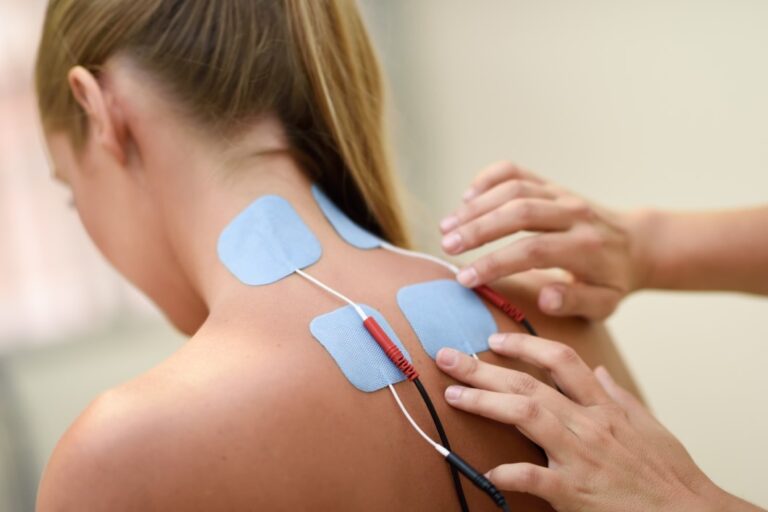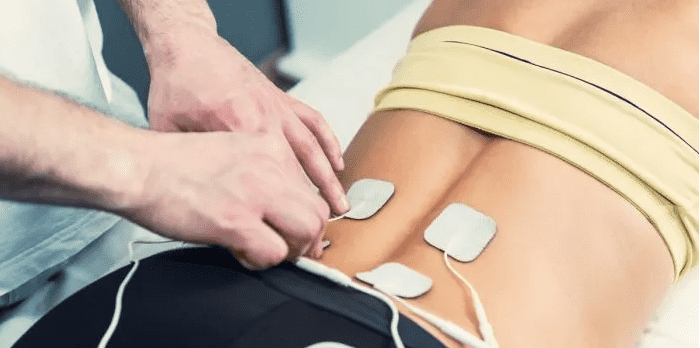A powerful tool used by many doctors, electrotherapy treats chronic pain, musculoskeletal injuries, muscle wasting, and neuralgia through targeted and controlled electrical stimulation.
Electrotherapy is a gentle, non-invasive modality that stimulates nerves and muscles through the surface of the skin. Electrotherapy is believed to work in several ways, depending on the device the doctor uses, they are:
- Provides electrical impulses that block or interfere with the body’s pain signals in order to reduce pain.
- Helps release endorphins (chemical messengers) that naturally relieve pain in the body.
- Stimulates muscle tissue to contract and reduce atrophy.
- Creating a warming effect on the body that improves circulation and stimulates healing.
- Stimulates cells to reduce inflammation, promote collagen production and reduce pain.
WHAT ARE THE TYPES OF ELECTROTHERAPY?
Transcutaneous Electrical Nerve Stimulation (TENS):
One of the most common electrotherapy treatments, Transcutaneous Electrical Nerve Stimulation (TENS) uses small devices which deliver the electrical stimulation through pulses. The aim of TENS machine is to stimulate sensory nerves to achieve pain relief and is often used for both nerve pain and chronic pain conditions.
Therapeutic Ultrasound:
In physiotherapy, therapeutic ultrasound uses deep thermal effects on various tissues such as muscles, ligaments, and tendons to increase blood flow and stimulate the healing process. This technique uses a transducer instead of electrode pads and is often used to treat strains, tendonitis, and knee meniscus tears. Therapeutic ultrasound is often used to treat chronic pain and promote tissue healing. It is recommended for those who meet the following conditions:
- carpal tunnel syndrome
- shoulder pain, including frozen shoulder
- tendonitis
- ligament injuries
- joint tightness
Interferential:
Interferential electrotherapy, also called IFT, uses low-frequency electrical stimulation that stimulates muscles, increases blood flow, and reduces pain. IFT may be used in patients who do not like the feel of TENS electrotherapy.
Electrical Muscle Stimulation (EMS):
Some electrotherapies target nerves, while EMS targets muscle tissue. This special form of electrotherapy stimulates motor neurons and causes muscles to contract. It is often used when treating and preventing muscle atrophy.
Shockwave Therapy:
Shock wave therapy uses high-energy sound waves for treatment. Similar to therapeutic ultrasound, shockwave therapy uses a transducer that contains gel. This treatment is used to stimulate collagen production, unblock painful trigger points, and reduce inflammation in the body. It is also very useful for musculoskeletal diseases like plantar fasciitis, tennis elbow, and achilles tendinopathy.
WHERE WILL YOU GET THE BEST ELECTROTHERAPY TREATMENT?
- Specialty Care Clinics specialize in Electrotherapy.
- You can seek a comforting electrotherapy treatment that gives excellent results.
- Our team of professionals is well-versed in the new technologies of electrotherapy.
- Medication is an ongoing process and requires much more investment compared to electrotherapy.
- Electrotherapy is a scientifically supported treatment for pain and swelling.
- If you experience symptoms of pain and swelling contact Specialty Care Clinics immediately to avoid severe pain conditions.
- For better electrotherapy treatment, visit specialtycareclinics.com or call 469-545-9983 and book an appointment.
WHICH WAVEFORMS ARE USED IN ELECTROTHERAPY?
The various waveforms used in electrotherapy are developed to target specific areas of the body and provide a customized form of energy exchange. This difference in energy transmission helps meet different therapeutic needs. The different waveforms used in the process of electrotherapy are:
- Transcutaneous Electrical Neural Stimulator (TENS): TENS works to relieve pain by blocking signals of pain from reaching the brain. The stimulation of TENS encourages the building of endorphins, making it an approved waveform for treating neck and back pain.
- Russian Current: The Russian Current waveform alternately emits mid-frequency energy. This makes it a popular waveform when it comes to building strength and retraining specific areas of the body. Russian Current also stimulates the release of pain-relieving endorphins, increasing its versatility and uses.
- Microcurrent: Microcurrents are also used for wound healing by using micro-sized pulsating currents. Due to its low intensity, microcurrent is the most acceptable waveform for electrotherapy.
- High Voltage: High Voltage electrical stimulation is a monophasic waveform that stimulates tissue using polarity (positive or negative). This is a popular method for reducing pain and swelling, reducing muscle spasms, and wound healing.
- Biphasic Current: “Biphasic” has two pulses with two different intensities. They alternate during the treatment, making it very versatile. Biphasic current can be used for a variety of goals in both acute and chronic problems.
- Premodulated Current (Premod): The premodulated current, also called “premod”, is similar to the interferential current. The main difference is that the premod current uses a single channel to mix frequencies before the current reaches the patient. This is suitable for treating small areas of the body such as elbows, ankles, feet, or hands.
- Interferential Current (IFC): Interference current (also known as IFC) is a waveform used for the treatment of chronic, post-surgical, and post-traumatic acute pain. The IFC is non-invasive and has minimal side effects. Because IFC provides higher frequency energy, it penetrates the skin barrier more easily, allowing deeper access to painful areas, but also increases tolerance.
Whether treating an acute injury or chronic pain, electrotherapy with various waveforms allows physiotherapists to non-invasively treat a variety of patient problems without complications or side effects. With available portable units, patients can also use electrotherapy in their homes or office to provide an alternative to traditional oral pain medications. These advantages make electrotherapy one of the most effective and popular physical therapy.



